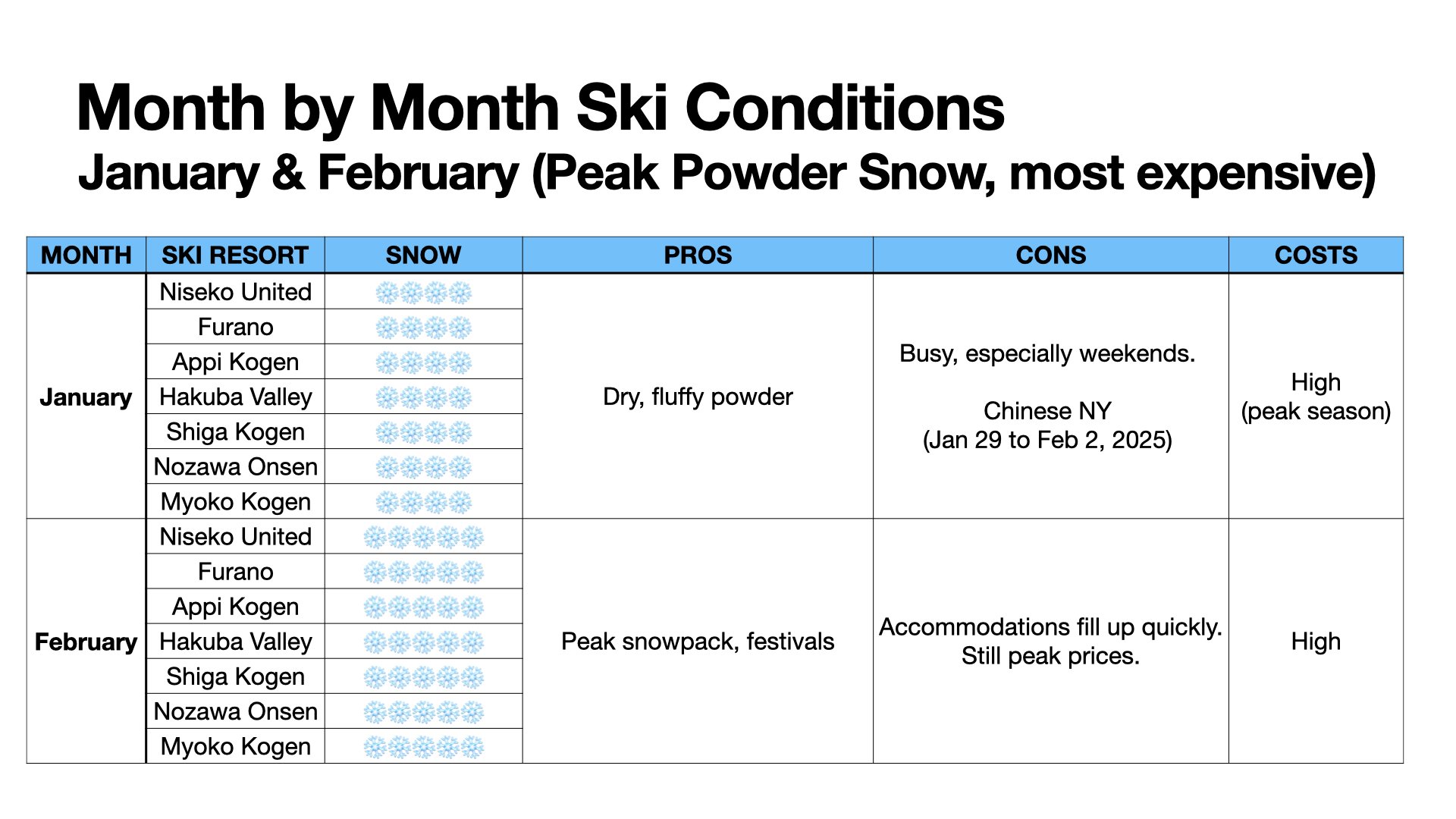When is the best time to ski Japan?
Timing is everything when planning a ski trip to Japan. From chasing the legendary powder to finding budget-friendly options or avoiding holiday crowds, your priorities will shape the perfect trip. Japan’s ski season offers a variety of experiences depending on when and where you visit. Let’s dive into what makes each part of the season special, with tips to help you plan.
Japan’s Ski Season
Japan’s ski season generally runs from late November to early May, though the duration and quality of snow depend on the region. The snow belt along the Sea of Japan coast—referred to as “snow country”—is famous for abundant snowfall. Northern areas like Hokkaido feature dry, light powder due to cold temperatures, while Nagano and Niigata enjoy consistent heavy snowfalls on Japan’s tallest mountains.
Each ski area has its unique timeline. Here's a snapshot of typical seasons:
Hokkaido (Niseko, Furano): Late November to early May
Iwate (Appi Kogen): Early December to late April
Nagano (Hakuba, Nozawa Onsen, Shiga Kogen): Early December to late April
Niigata (Myoko Kogen): Mid-December to mid-March
Powder Chasers: Best Months for Peak Snowfall
January and early February are prime time for skiers and snowboarders seeking Japan’s famous powder snow. During these months, consistent snowfall and deep snowpacks make it a dream destination for powder enthusiasts.
Hokkaido: Resorts like Niseko average 15-18 meters (49-59 feet) of snowfall annually, with January being the snowiest.
Nagano and Niigata: Snowpack peaks from mid-January to early February, often reaching depths of 300 cm (118 inches).
Tip for Powder Hunters:
To enjoy untracked powder with fewer crowds, avoid visiting during the New Year and Chinese New Year holidays. Midweek skiing is another great way to maximize your experience without the bustle.
Budget-Friendly Ski trip for Japan: Save money on your Japan Ski Trip
Skiing in Japan doesn’t have to break the bank, especially if you’re flexible with timing. Budget-friendly months include early December and late March to early April.
Early December: Resorts in Hokkaido and high-altitude areas in Nagano often open with discounts on lift passes and accommodations. However, snow conditions can be less reliable. Mid-December offers better coverage at reasonable prices.
Late March to Early April: Snow quality declines at lower elevations, but high-altitude resorts like Shiga Kogen maintain solid snow depth. Lift tickets and accommodations are heavily discounted during this period.
Money-Saving Tips:
Beginners can use free practice areas before purchasing lift tickets.
Opt for single-ride lift passes or half-day options instead of full-day passes.
Consider buying secondhand ski gear in Japan instead of renting—it’s often cheaper and more convenient.
Quiet Slopes: Avoiding Crowds
If avoiding crowds is your priority, steer clear of peak holiday periods:
New Year’s (Dec 29–Jan 3): One of the busiest weeks of the year.
Chinese New Year (varies, late Jan–mid-Feb): Popular among international tourists.
Weekends: Local skiers flock to resorts, even outside holiday periods.
For a peaceful experience, plan your visit midweek or during early March, when visitor numbers drop but snow conditions at higher altitudes remain excellent.
Tip for Crowd-Free Trips:
Explore smaller, lesser-known resorts. These are often quieter, cheaper, and ideal for beginners.
Month-by-Month Breakdown of Japan’s Ski Season
When is the best time to ski Japan?
Ski Japan in December
November: High-altitude resorts like Niseko may open, but snow is limited.
December: Early December offers discounts, while late December brings holiday crowds.
Best time to ski Japan for powder now
January: The best month for powder, with consistent snowfall.
February: Similar to January but slightly quieter after Chinese New Year.
Ski Japan in March and spring skiing in Japan
March: Transition to spring skiing with fewer crowds and sunny days.
April: Late-season skiing at high-altitude resorts like Shiga Kogen and Hokkaido.
Skiing Japan in April can mean both skiing and cherry blossoms can be combined
Insider Tips for Timing Your Ski Trip
Ski Midweek: Avoid weekends for quieter slopes, even in peak months.
Book Early: For trips in January or February, secure accommodations and rentals at least six months in advance.
Stay Flexible: Leave room in your schedule to adjust for snow conditions.
Try Smaller Resorts: Local resorts often have gentler slopes, cheaper passes, and fewer visitors.
Stay Central: Instead of staying at one resort, choose a central location and visit multiple ski areas.
Get my Guide and Map: Check out my guide and map if you really want to make the most of your trip. I’ve included my best tips and recommendations for ski resorts, attractions for days off the snow, restaurants, and cafes.
Final Thoughts
Japan’s ski season has something for everyone, whether you’re chasing powder, traveling on a budget, or seeking peaceful slopes. Timing your trip is crucial to making the most of your experience. For more detailed advice, check out my travel map, featuring insider tips and lesser-known activities.
Plan ahead, stay flexible, and get ready to hit the slopes!
Looking for a bespoke winter trip with me as your guide? Take a look at www.orija.me for my exclusive trips!




